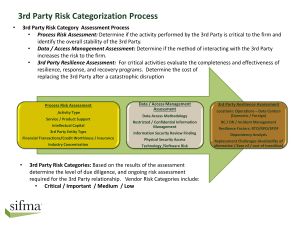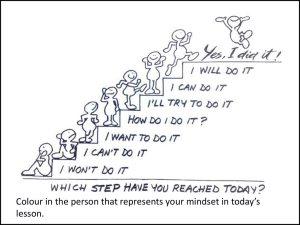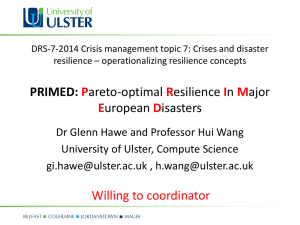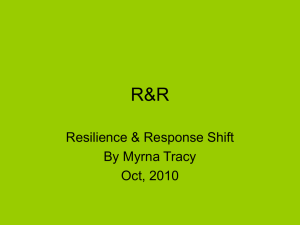RESILIENCE: CAUSAL PATHWAYS AND SOCIAL ECOLOGY
advertisement
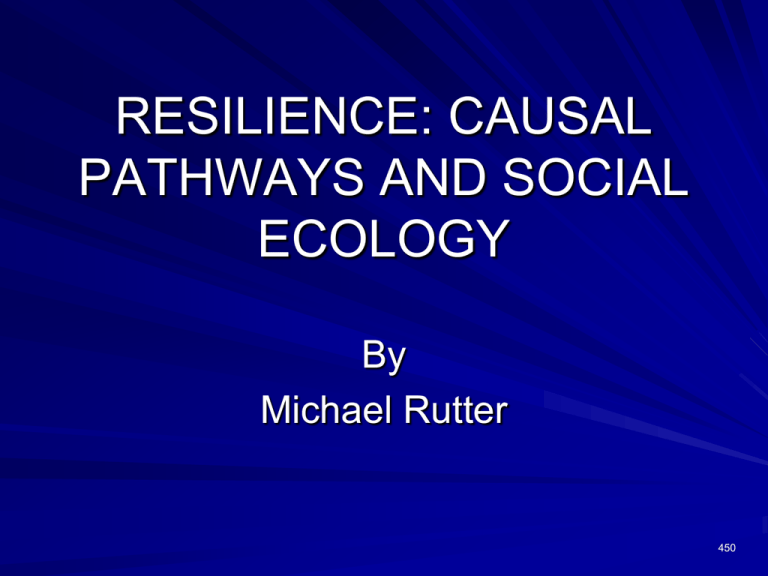
RESILIENCE: CAUSAL PATHWAYS AND SOCIAL ECOLOGY By Michael Rutter 450 Resilience = Relative resistance to environmental risk experiences OR The overcoming of stress or adversity OR A relatively good outcome despite risk experiences (N.B. It is not just social competence or positive mental health) 2 Background = Universal finding of huge individual differences in people’s responses to all kinds of environmental hazard PLUS Evidence of ‘steeling’ effects in which successful coping with stress or adversity can lead to improved functioning and increased resistance to stress/adversity 3 RESILIENCE IS AN INTERACTIVE CONCEPT It requires demonstration of an effect that operates in the presence of stress/adversity but not in its absence i.e. – NOT the same as competence or well-being And – NOT the same as positive influences or positive mental health 4 IS RESILIENCE JUST A FANCY WAY OF RE-INVENTING CONCEPTS OF RISK AND PROTECTION? I No, because risk and protection start with a focus on variables and move to outcomes with an implicit assumption that the impact of risk and protective factors will be broadly similar in everyone, and that outcomes will depend on the mix and balance between risk and protective influences 5 IS RESILIENCE JUST A FANCY WAY OF REINVENTING CONCEPTS OF RISK AND PROTECTION? II By contrast, resilience starts with a recognition of the huge individual variation in people’s responses to the same experiences, and considers outcomes with the assumption that an understanding of the mechanisms underlying that variation will cast light on the causal processes and, by so doing, will have implications for intervention strategies with respect to both prevention and treatment 6 DO RESILIENCE CONCEPTS REJECT THE TRADITIONAL STUDY OF RISK AND PROTECTIVE FACTORS? NO because 1) there is an abundance of evidence that much of the variance in psychopathological outcomes can be accounted for by the summative effects of risk and protective factors because 2) resilience is an interactive concept that can only be studied if there is a thorough measurement of risk and protective factors 7 CAN RESILIENCE BE MEASURED DIRECTLY AS AN OBSERVED TRAIT, RATHER THAN HAVING TO RELY ON AN INFERENCE BASED ON SOME KIND OF INTERACTION, HOWEVER ASSESSED? NO, because it is not a single quality. People may be resilient in relation to some sorts of environmental hazards, but yet not others. Equally, they may be resilient in relation to some kinds of outcomes but not others. In addition, because context may be crucial, people may be resilient at one time period in their life but not at others 8 LESSONS FROM RESILIENCE FINDINGS I 1. Resistance to environmental hazards may come from exposure to risk in controlled circumstances, rather than avoidance of risk. c.f. Natural immunity to infections and immunisation Animal experiments (e.g. Levine) with physical stressors Treatment of phobias California studies (Elder) in the economic depression N.B. Paucity of evidence, and great need to consider both physiological mediation and cognitive/affective mediation 9 LESSONS FROM RESILIENCE FINDINGS II 2. Protection may derive from circumstances that are either neutral or risky in the absence of the key environmental hazard c.f. heterozygote sickle cell status and malaria adoption for children exposed to abuse/neglect 10 LESSONS FROM RESILIENCE FINDINGS III 3. Protection may derive from what people do to deal with stress/adversity (that is, the notion of resilience focuses attention on coping mechanisms, mental sets, and the operation of personal agency. In other words, it requires a move from a focus on external risks to a focus on how those are dealt with) 11 STRATEGIES FOR STUDYING RESILIENCE 1. Focus on positive turning point effects in individuals from a deviant background 2. Focus on features associated with educational/occupational success in individuals from a disadvantaged background 3. Focus on individual differences in outcome following serious stress/adversity 12 OUT OF THE WOODS: TALES OF RESILIENT TEENS by Stuart Hauser, Joseph Allen & Eve Golden, 2006 Follow-up into adult life of 67 young people who were patients in an inpatient adolescent psychiatry unit Comparison of 9 who showed outstanding resilience and 7 who were 'ordinary' Three key elements characterised resilience: 1. personal agency and a concern to overcome adversity 2. a self-reflective style 3. a commitment to relationships 13 SHARED BEGINNINGS, DIVERGENT LIVES John Laub & Robert Sampson, 2003 Follow up to age 70 years of Gluecks' sample of 500 incarcerated adolescent delinquents and 500 matched nondelinquents Plus Detailed life history interviews of 19 desistors, 14 persisters and 19 with a zig-zag course Turning point effects associated with resilience Military service Marriage Employment Plus Human agency exercising focussed choice 14 PROTECTIVE ELEMENTS IN MARRIAGE 1. Social support & commitment 2. Informal social control 3. Change in routines & lifestyle activities 4. Residential change 5. Birth of children and consequent effects on responsibilities 15 MILITARY SERVICE AND LATER SOCIOECONOMIC ACHIEVEMENT (data from Sampson & Laub, 1996) Key predictors of success: Overseas duty Training under the GI Bill Lack of a military arrest but interactions with Early entry to military service N.B. effects of military service comparable to those of measured ability and much greater than SES or educational achievement 16 ELEMENTS IN EFFECTIVE SCHOOLING From Rutter et al, 1970, '15,000 Hours' Crucial role of social experiences is differentiating between effective and less effective schools (as judged by pupil success) – Academic emphasis & high expectations – Children treated positively and given multiple opportunities for responsibility & success – Teachers provided models of conscientious behavior together with an interest in, and a positive response to, pupils' work & other activities 17 COMMUNITIES FOSTERING RESILIENCE Chicago study by Sampson et al (1997) showed that crime was highest in areas showing social disorganization and a lack of collective efficacy. That is, the area differences in crime were not a result of noxious influences pushing individuals into crime but, rather, a lack of a positive social ethos that protected individuals in a high risk area. Bruhn and Wolf's (1979 & 1993) study of Roseto in Pennsylvania showed that an unusually low rate of deaths from heart disease seemed to derive from a powerful egalitarian social structure involving an unusual degree of collective 18 efficacy OUTLIERS FOR ECONOMIC SUCCESS (Gladwell, 2008) Opportunity + Practice + Multiplier effect 19 EXAMPLES OF OPPORTUNITY THROUGH PHYSICAL MATURITY High proportion of ice hockey stars born in first 3 months of the year – Because more physically mature This led to high intensity training providing a multiplier effect Extended practice added to this (cf the '10,000 Hours Rule') 20 VALUE OF MEANINGFUL WORK Autonomy Complexity Connection between efforts & reward 21 TERMAN'S STUDY OF BOYS WITH AN IQ OF AT LEAST 140 Follow-up showed – 1/5th outstandingly successful in adult life But – 1/5th strikingly unsuccessful (dropping out of college & struggling in their work) 22 DIVERGENT PARENTING STYLES (Lareau, 2003) 'Concerted Cultivation' 'Accomplishment of Natural Growth' Active intensive scheduling of activities Care of children but style of letting them grow & develop on their own Expectation that children compliant & obedient Expectation that children talk back, negotiate & question Fostering 'sense of entitlement' No fostering of active entitlement 23 RESILIENCE: CAUSAL PATHWAYS AND SOCIAL ECOLOGY By Michael Rutter 450 SOCIAL CONTEXT: KEY ELEMENTS Provision of social support at an individual level : emotional : practical Provision of community resources Source of friends & love relationships 25 IMPORTANCE OF OPPORTUNITY GI Bill providing entitlement to college education Hamburg clubs opportunity for the 'Beatles' Opportunity of period of economic expansion New opportunity of free access to timesharing mainframe computer Physical maturity Being part of a smaller birth cohort 26



